Video
youtube
Drone
Noun: A Deep Sustained Or Monotonous Sound
The following is an excerpt from Drone director Sean Buckelew's much longer in-depth behind-the-scenes article found here.
Drone is concerned with some pretty lofty concepts and we wanted to be sure we fully understood the director Sean Buckelew’s point of view before we dove in, so we requested a reading list and pounded through some relevant literature in front of a log fire on our Christmas break. We found Frankenstein to be the most fruitful reference, paralleling so many of the key ideas in Sean’s script in an equally lyrical way.
To kick us off, Sean sent us a WIP along with some spotting notes. In true Buckelew fashion, they were fun & casually worded but extremely well thought-out.
His first note: “Overall, I think the sound/music oscillates between two modes: one is kind of bureaucratic and banal, the other is dreamy, impressionistic and poetic” presented to us the idea of a duality at the heart of the story. So, borrowing a technique from David Sonnenschein’s book Sound Design: The Expressive Power of Music, Voice, and Sound Effects in Cinema, we plotted a table of two columns with relevant motifs aligned with the two main ‘modes’ that Sean discusses. We thought the film a little too nuanced to label “good vs evil” or “man vs machine” so we decided upon the much broader terms “Inside” & “Outside” to name the two forces.
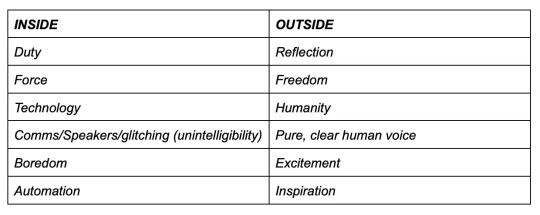
Our “Bipolar Evaluation” of Drone:
We then mapped out the timeline of the film with colour-coded slugs that tracked the two main polarities to help us plot the emotional beats of the story arc, forming a solid guide for us to follow while we worked.
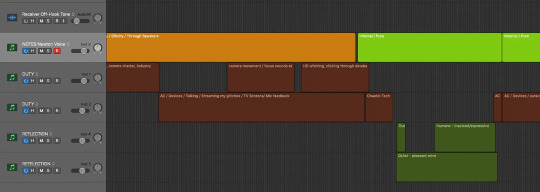
A couple of weeks later, we presented our first sketch to Sean: We went big from the outset, unabashedly invoking signifiers from the sub-genre of ‘hollywood flying music’, Namely: a soaring melody, vivid chordal gestures, and rich, lush strings over a floaty waltz feel. This OTT feeling seemed to elevate Newton’s monologue into the realm of fantasy, contrasting with the cold cynicism of the office scenes.
In a previous collaboration with Sean, Lovestreams, we relished the opportunity to create an Enya-inspired, floating & ethereal ‘semi-New Agey’ score that could perform on a dual level: Being playfully ironic while legitimately tugging at heartstrings. We approached Drone with a similar sensibility.
vimeo
Sean’s response was very enthusiastic: “you guys are fucking brilliant, skillbard strikes AGAIN!!!!”. Smashed it first time!
But really all credit goes to Sean for making it easy to get right. When a filmmaker understands their message, thinks things through as thoroughly as Sean does, and takes the time to communicate so effectively with collaborators, it starts to feel like all we need to do is go away and start pressing the buttons. He had notes, of course, but nothing major, so we pressed on, fleshing out our demo and writing cues for the rest of the film, sending regular WIPs to Sean for his thoughts. We also started work on the sound elements, focusing mostly on the bombing scene to establish overall dynamics of the film, since that’s the loudest/most intense bit.
vimeo
Now we had established the musical DNA for Newton’s journey and we set about extrapolating, variating and developing outwards to set up the other cues.
EG During Newton’s death cue we rendered a sombre, minor-key variation from the core motif.
As usual, music was the most noticeable emotional & atmospheric signifier but every sound you hear was considered in terms of how it contributed to the story emotively, narratively & even conceptually. Perhaps the most obvious example is processing of the dialogue EG: a feeling of alienation was often achieved through tactical intelligibility of dialogue. It’s not always clear what Newton is trying to tell us while he’s delivering his manifesto because, ultimately, it was never heard or understood outside of creating a spectacle.
Similarly, a lot of the dialogue in Drone is heard through speakers, we’re not sure if this is something we discussed with Sean but our perception was that this was an expression of technology’s power to create distance between people. It seemed important that this is something that is felt by the audience. We did a lot of ‘reamping’ by hacking gritty, small speakers to make this talker—>listener detachment palpable.
vimeo
Once all the music was written and demoed and approved by all parties, we sent our sample-based mockups to our talented orchestrator Finn McNicholas (Midsommer, Daniel Isn’t Real, Swansong) and briefed him on how we’d like them to end up when played by the orchestra. Finn listened carefully to what we’d programmed in MIDI, transcribing it to page to achieve everything we were expressing in a way a room full of 30 people can understand and play without complication.
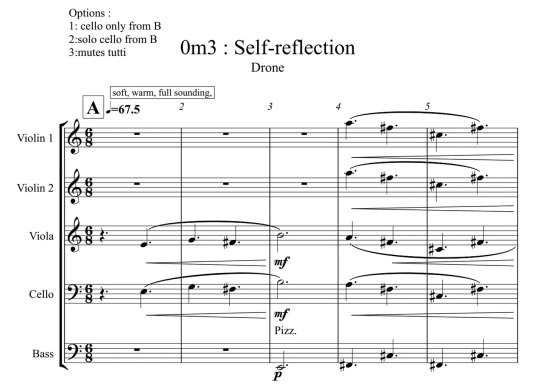
See the full scores for this cue here.
To invoke Newton’s destructive intentions, Finn helped us pin down and notate a number of ‘extended techniques’ for our orchestra to try; often ‘unmusical’ playing styles that push the instruments outside of its regular usage into more savage tones.
This musical thread begins during the night time cue ‘Alienation.’ Newton’s monologue describes an “interwoven fabric” while we see a spaghetti junction. We wrote a long sustained drone featuring an airy random textural movement from the string players, giving a musical sense of threads rubbing together.
Later in that cue when Newton describes the destruction he is about to bring forth while we see a field in flames, we wrote two powerfully opposing chords with a tense and nervous tremolo, going between ‘sul tasto’ (string player playing close to the neck) and ‘sul pont’(string player playing close to the bridge) to express his destructiveness and contradictory nature.
In the death scene after he crashes we hear a scratchy gnarly string articulation, Newton’s full destructiveness wrought…
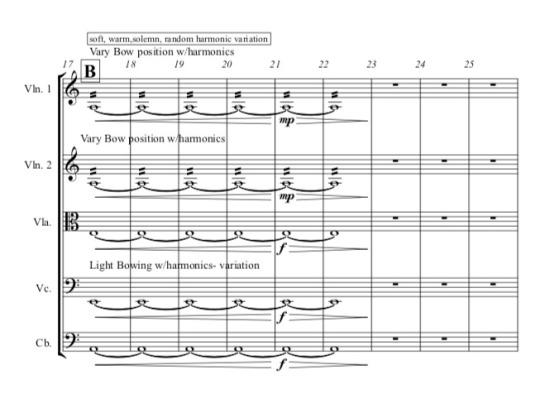
When we had worked through exactly what we wanted with the orchestration, we attended and directed the session with the Budapest Art Orchestra (Queen’s Gambit, Locke & Key, Godless).
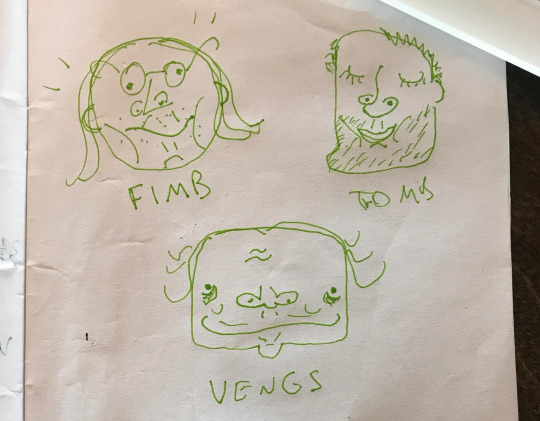
A portrait of two composers and orchestrator on the day of recording
Covid prevented us from attending the session personally—which was a shame because a pint of beer in Budapest is like £2!
vimeo
Unfortunately their live room camera fell over immediately upon starting our session so this is the best angle we have.
Hear each cue in isolation here:
13 notes
·
View notes
Video
vimeo
Honour
Although director Frederic Siegel said he contacted us after hearing our work in things like Majestic Wilderness by Elenor Kopka and Island Bozo by Jonathan Djob Nkondo, he approached us to ask for something completely different: A “pretty serious style of sound”. Something, he acknowledged, is not quite what we were known for heheh. We hope his little risk has paid off.
A year later, when it was time for Vimeo Staff Picks to premiere the film, we wrote a few paragraphs about our process for this blog post. Perhaps we were a bit too wordy as none of it was used… Oh well, here it is on the Skillblog. Enjoy!

Music
There are two main musical territories within Honour: 1 The cold, technological, metallic synths and percussion we hear when we are presented with images of man-made structures etc and 2 The softer, warmer, more organic ‘frilly’ notes we here when Frederic brings us into nature. Although we wanted each of these facets of the score to be ‘otherworldly’, as our interviewer astutely puts it, we wanted them to be markedly different in feeling.
For the synthesised chords we experimented with the kind of brittle, glassy/metallic FM synthesis that you hear in Radiohead’s Idioteque (which is a sample from Paul Lansky’s Mild Und Leise), in order to create something both alien and hi-tech.

For the musical soundscape that represented the planet’s nature, we took influence the heavy atmosphere of from pieces such as Einojuhani Rautavaara's Cantus Arcticus and Fourth World, Vol. 1: Possible Musics by Jon Hassell/Brian Eno, and these influenced the bird-like woodwind trills and pitch shifted woodwind sounds.

During the “Action” scene in the climax of the film, we used a combination of metallic percussion, and physical modelling synths as this seemed to complement with the images of the scientist’s engineering; the hammer and the gas canister. We paired this with very irregular rhythms and accents, so the sequence had a chaotic, organic element, like the jungle planet itself.
Sound
For the jungle sounds, we recorded ourselves mimicing slow-d down bird and animal calls, and then sped them back up. This is something we’ve done in a few projects and have found it’s a great way to get animal sounds that sound unreal or “alien.” And these sounds are then very controllable because of the way we have them isolated without any background noises.

For the sound of the scientists in their helmets, we recorded a lot of breathing into a fish bowl so we had to be sure we were extra diligent with our dental hygiene ;).
The running in the forest was quite a tricky one. Most footsteps can be dragged in from sound libraries to save time but we felt that the running scenes were so important to the film that we wanted to record our own. Luckily a studio neighbour had just finished doing a lot of gardening and we helped ourselves to three bin bags full of twigs and leaves to fill our studio floor with and stop around on

15 notes
·
View notes
Video
youtube
Genesis Noir
For the passed few months we’ve been working with Feral Cat Den, making sounds and music for their forthcoming point-and-click cosmic adventure Genesis Noir. It’s still early days and we don’t expect the game to be released for another couple of years but you can stream and download a whole song already.
Below is some info we’ve put together for the (now successfully completed) Kickstarter campaign so we thought we’d share it in a nice blog post. Enjoy!

Genesis: Getting Started
When we first started talking to Feral Cat, it was clear they’d given the music and sound a lot of thought. They wanted it not just to be a soundtrack but an integral part of gameplay though adaptive scores, sound toys and music games throughout the adventure.
“Much like the visuals, we are imagining the auditory experience of Genesis Noir to be simple, spacey, a tad experimental, but also textual and evocative”.
We talked about musical and other influences (Cosmic and spiritual jazz, film noir etc) and discussed the balance between natural and synthesised sounds. The whole time we felt like Feral Cat Den were hitting the nail on the head with their brief; we were on the same page and ready to roll!

So Far…
We can’t talk too much about our process yet, because there’s still so much to figure out and implement—thanks for your funding to help get us to that stage!—but here’s some jive on what we’ve created so far:
We spent a bit of time thinking about the references and influences. We have quite a delicate balancing act to do to achieve the kind of story texture and sense of wondrous adventure that we’re going for. We want to marry the hyper-real, grounded and serious sense of peril of film-noir from the ‘40s with the other-worldy, spiritual wanderlust of Sun-Ra & contemporaries as well as sneaking in a little gut-punch impact of the kind our modern-day technology allows. Rather than choosing an area of influence and aping it, we want to draw from it where it contributes best to the narrative and atmospheric goals of the game.

Perhaps one good example is the genesis, itself. One tiny moment that changes everything; the gun shot:
SFX: The Small Bang
When thinking about Noir, this has got to be one of the first sounds that comes to your mind. It’s not the huge and over-hyped “KABLAM, KABLAM” you’d hear mowing down countless nameless henchmen in a Governor Arnie flick. It’s actually a relatively small sound. A quick, soft, tape-saturated “pap!”. In a noir, a murder hits you harder because it sounds more real… partly.
The gun in Genesis Noir is the one that (in at least one timeline) kills the woman you love so this realness is something we wanted to capitalise on. For this reason we didn’t go with the biggest, most impressive video game explosion we could muster, we went for the ‘noir pap’.

Music: Miss Mass Theme
Similarly, with the music, we didn’t opt for totally embracing one single area of inspiration. Again, we aimed for that funambulism (we looked up the posh word for tightrope walking) between genres—most notably ‘Musique Noir’ and Spiritual or cosmic Jazz—so that we could draw from each as we saw fit.
We didn’t know much about Miss Mass before we wrote her theme… In fact, this is it:
—The lover.
—An alluring jazz singer.
—Attractive (literally).
…But maybe, if we were in a film noir, we might turn to her and say “I know your type”. We made her bold but lyrical, powerful but emotionable, spacely-exotic and ethereal. We took a noirish backbeat and combined it with the fantastical, boundless jazz explorations of Alice Coltraine. We also popped a little auditory illusion in there [for reasons that have been redacted to avoid game spoilers] — the descending piano chords you hear at 55s in the song are a Shepard tone; they could go on forever and never sound they’re going to stop falling downwards.

More info at genesisnoirgame.com
0 notes
Video
vimeo
Born In A Void
Making The Sound & Music
To accompany this Making-Of document by director Alex Grigg, please enjoy this short run-down of how we created the music and sound of Born In A Void, which was released as part of Late Night Work Club short film anthology in November ‘16.
On this film everything started in quite an improvised, intuitive way and we had decided on a synesthetic approach where sound design bled into music and vice versa. These factors led to the more musical elements of the film coming together in quite a patchwork fashion, where we had multiple jams that we had created using many different approaches.
Jams
Our original Jam session:
We started working on Born In A Void in July 2016. Alex sent a little test clip and a reference track (Turtles by Flying Lotus) and we had a little chat about textures and atmospheres. Based on this we went into the studio and had a quick jam on a an Elektron Octatrack, using its sample warping tools to create something satisfyingly squelchy and edible. A quick, loose beat and some chimey bells later and we sent it over to Alex.
In the opening of the film, you can hear a mixture of our Octatrack jamming and a juju bean rattle as the sound of these blobs forming:
vimeo
From there we waited until the bulk of the storyboarding and some of the animation was done before getting back into it. When we watched the rough film, we instantly knew we wanted intense, rushing, frenetic, splashy drums on the sun-suckin’ bits but a more closed, intimate, muted and cosy feel in the character’s exploring moments. For this we enlisted the help of a drummer friend of ours Ali McCabe from IDR.
Jums
We played the film to Ali—the first time he had seen it—on a big screen in the studio and started recording right away. One of us stood in the live room ‘conducting’ Ali throughout his takes, gesturing wildly and looking stupid. We’d franticly mime the crescendo of feelings and textures we wanted to achieve and Ali would have the difficult task of translating our mimes into a drum performance.
Here’s a tiny clip of Vincent miming for Ali:
vimeo
The Result:
vimeo
Next we did some more traditional drum takes and laid down the backbone of the piece: the beats! And they were so smoooth.
The beat:
vimeo
Jums As SFX
Thirdly, we recorded the incidental, sound effect drums moments. Zooming in on particular moments of the action, we tried some traditional and non-traditional drum fills and clacks to achieve something musical that described the on-screen action. The cartoony bits!
Drums as SFX:
vimeo
And finally, we selected an arsenal of delightful, contrasting percussion instruments and cymbals and just went wild. Everyone played this time, using a mixture of all the techniques above to further vary the textures of Ali’s recordings.
A selection of some of the handheld percussion instruments (and non-instruments).
Less Jums
Once everything was recorded and pieced together, we set about stripping it back. We must have muted 75% of the drums and percussion we recorded. Our score was all about contrast and to achieve that we needed to clear out our recordings to leave space for various different sounding elements. Alex had a good idea of how the weight and texture of the objects in the film should feel so we worked closely with him to decide on a mix of synthesized sounds, traditional foley and treatments of our recordings to build up a varied, textured and expressive soundscape.
Then we mixed it the end.
The End
Thanks for reading!
1 note
·
View note
Photo

The Sound Of The Future
(also music)
We started working on The Future in May 2015 after seeing a little GIF Greg had posted on his Tumblr account. It was something like this…

…with the caption “vrup vrup vrup vrup”. We instantly responded with a Tumblr comment “We want to make them vrups”. For us it was a no-brainer. It’s difficult to put our finger on why or how this short clip spoke to us as much as it did but from it we felt it was apparent that the film was going to be very different. It seemed to have a unique atmosphere and the kind of off-kilter sense of humour Skillbard specialises in. It also seemed from Greg’s caption that he was thinking of the sound as an integral part of that atmosphere and humour… maybe. This is the kind of project we want to get involved with. Luckily Greg responded and that was that. Easy.
The Sax
It was Greg who first mentioned the saxophone. The only thing close to a brief he gave us was this one idea to have something like the first two seconds of this, to be used at 51s into the film where our hero’s face lights up. It’s genius. Greg’s a genius. Our response was “We think your sax idea is tops. It’s the perfect instrument for giving you dry ears so we went with some dizzy-from-the-heat bendiness and screechy, poorly played sax to punctuate some moments, building into a kind of fucked up beetle battle march. We took inspiration from one of our most favourite bands in the world: Zs.“
This was our first sketch:
Perhaps it’s quite clear that neither of us play the saxophone and we think that helps.
Planet Of The Apes
After trying to figure out why the first sketch wasn’t quite working, we stumbled upon an idea that energised us - our mutual love for Jerry Goldsmith’s music for Planet of the Apes. We drew a lot of half-remembered influence from that score and ended up keeping the Shronking sax and adding some tibetan horn, bamboo jegog and prepared piano. All really colourful sounds that seemed to make sense in this desperate world. Musically we were using a whole-tone scale, but in parts it kind of devolves into a chromatic free for all.
The Sound
On the sound design side, we were really trying to hold everything back in the first half and help create this desolate world, in order to provide a lot of contrast with the surprisingly intense scary/funny second half where the music takes over. We layered in a bunch of whistling wind sounds to give the feeling of a dry, dry desert, and we created the sound of those dusty geyzers with a baaah vocal sound, layered with a bit of filtered blown trumpet and some dusty debris sprinkles. We created the sound of the “Vrups” by scratching a piece of foam with our fingers, and layering them with some more conventional footsteps.
The Voice
Being that every character is identical, the animatic was quite confusing so, along with the music sketch, we also recorded some rough dialogue. At first just to aide our understanding but Greg liked it and asked us to record it all proper for the final thing! We recorded about 50 throat-punishing takes (we’re not voice actors, after all), all with varying degrees of dryness and shoutiness. Here’s an unedited excerpt from one of the recording sessions.
Enjoy the full thing here:
vimeo
4 notes
·
View notes